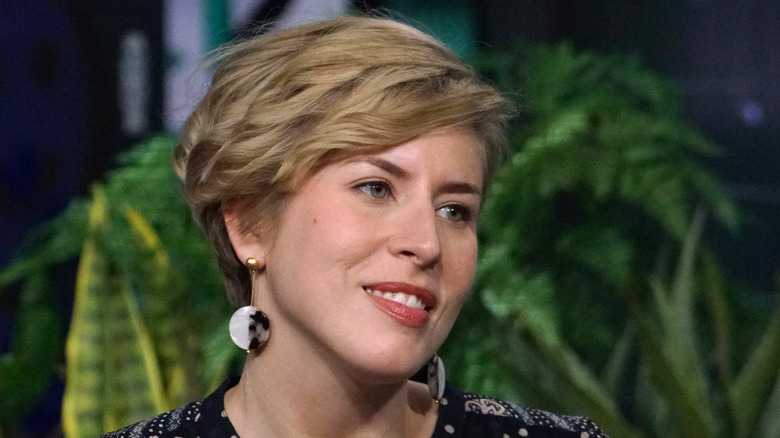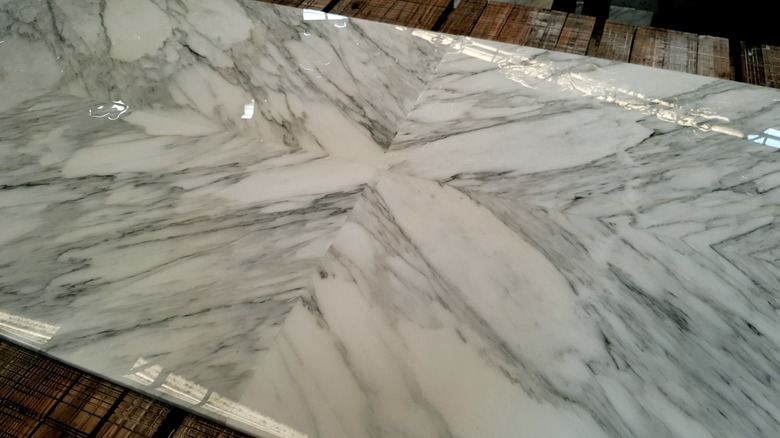Erin Napier Shares An Essential Feature Every Waterfall Countertop Should Have
People who want their kitchen to have a wow factor have been turning towards waterfall countertops more and more. These unique islands usually feature a stone slab — whether it's quartz or marble — that not only sits on top of the counter but extends down the sides of the cabinets, creating a waterfall effect. The end result is rather dramatic, allowing you to integrate more stone into your kitchen design and, thus, allowing it to pop. It also makes your kitchen feel more luxurious since the underlying message is that you spent more on materials due to the extra slabs cascading on either side of the island. However, not all waterfall islands are created equally. According to HGTV's Erin Napier, there is one crucial feature that every such countertop should have. This detail makes it appear more designer and polished, and that is that the veining carries over to the cascading sides.
"My favorite thing about the waterfall countertop is the veining continues over the edge," she said in Season 8, Episode 2 of "Home Town." "I mean, that's where the waterfall magic happens." According to Napier, for the slabs to truly create a cascading effect, the veins need to follow each other across all the slabs. If they don't, then it will just look like you pieced two or three different slabs together to create a boxed-in island. For it to be a proper waterfall, there needs to be continuity.
Why matching veins can be hard to achieve
It might seem obvious that waterfall countertops need to feature veining that continues across their entire design, but doing so is actually pretty hard to achieve. It needs to look like it came from one giant slab, but you usually can't get a slab large enough to achieve this effect. Because of this, using natural materials like marble, travertine, or granite can't guarantee you will have matching veining down the sides. To give you some context, the average marble slab is 10 feet long and 6 feet wide, but the average island is 6.5 feet long. This is usually the industry standard for slab size because producing something larger increases its weight and the difficulty of transporting and installing it.
So, to create a waterfall effect, you have to use a manufactured material such as quartz instead. Since it is manufactured rather than naturally made in the ground, this allows you to customize the vein placements, allowing you to have them match up. However, people who don't want quartz and instead have their hearts set on natural materials often need to choose between the material or not having the veins perfectly lined up. According to Napier, it's better to have the veins match.
The workaround for marble
If you have your heart set on using marble and want continuous veins in your waterfall countertop, there is one workaround. You can request to have something called bookmatch stone slabs. Rather than buying a marble slab, you instead buy a marble block, which gets shipped to a processing plant. Experts cut matching slabs from the block, and then one slab gets polished on one side, and the second slab gets flipped over and polished on the opposite side. So when you lay them flat next to each other, they create mirror images of each other, which will allow you to match up their veins. They look like you opened up a book down the middle, hence the name.
If you haven't heard of this technique before, that's because it's not common. It will cost you more than buying a normal marble slab or manufacturing a continuous slab of quartz. However, if you have your heart set on marble, a reputable countertop specialist can help you get an order in. The only caveat to keep in mind is that this only works if you choose a marble type that has bold, thick veins. You need those thick lines in order to make the mirror images obvious.


